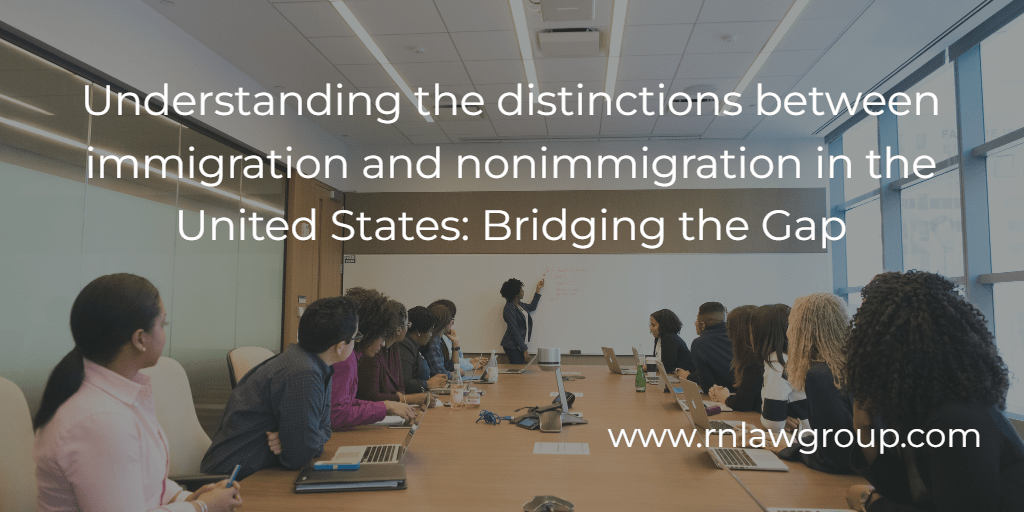
Understanding the distinctions between immigration and nonimmigration in the United States: Bridging the Gap
For many years, the United States has served as a guiding light for people looking for better prospects, a new beginning, or safety from unfavorable situations back home. The two main streams of immigration and nonimmigration can be used to roughly classify the ways to enter the United States. Although they both entail entering the United States, these two groups have different goals, procedures, and consequences. This article explores the subtle distinctions between immigration and nonimmigration in the US, illuminating the different factors that influence these distinct travel paths.
- Overview and Definitions:
- Immigration:
The act of people traveling to another country with the goal of relocating there permanently is referred to as immigration. In the United States, immigrants want to build a permanent or long-term home, eventually obtaining the status of lawful permanent residents (LPRs) and, in certain situations, applying for U.S. citizenship. The immigration system is set up to handle a variety of categories, including employment-based immigration, family-sponsored immigration, and humanitarian initiatives like refugee status and asylum.
- Nonimmigration
Conversely, nonimmigration refers to short-term visits to the United States. People in this group don’t plan to settle down for the long term. Rather, they travel for specified objectives like tourism, work, school, or diplomatic missions. Nonimmigrant visas are usually only issued for a short period of time, and holders are subject to the requirements specified in their particular visa category. The H-1B visa for skilled professionals, the F-1 visa for students, the B-2 visa for tourists, and the J-1 visa for exchange visits are typical instances of nonimmigrant visas.
- Goal & Objective:
- Immigration:
The intention of the individuals is the primary differentiation between immigration and nonimmigration. The goal of immigration is to start over in the United States and add to the social, cultural, and economic fabric of the country. In order to eventually become citizens of the United States, they frequently seek permanent residency. The main drivers of immigration are possibilities for job, humanitarian reasons, and family reunification.
- The absence of immigration:
On the other hand, nonimmigrants have well-defined, time-bound goals for their time in the United States. These goals could be going to college, getting a temporary job, going to conferences, or taking part in exchange programs for cultures. Nonimmigrants intend to return home when their permitted stay expires and keep ties to their native nations.
III. The Law:
- Immigration:
The Immigration and Nationality Act (INA) governs a complicated legal framework that must be navigated during the immigration process. A comprehensive series of qualifying requirements, which may include humanitarian concerns, employment sponsorship, or family ties, must be followed by prospective immigrants. In-person interviews, background checks, and copious amounts of documents are frequently needed for the process.
- The absence of immigration:
Although they are nonetheless bound by immigration regulations, nonimmigrants are subject to a distinct legal system. They receive temporary visas, each designed to serve a particular function. Nonimmigrant visa applications usually follow a more simplified procedure that focuses on the particular criteria of the intended stay. Nonimmigrants must still abide by all immigration laws in the United States, nevertheless, including keeping their status lawful and honoring the conditions of their visa.
- Length of Stay:
- Immigration:
The goal of immigrants is to settle permanently in the United States. After being awarded the status of lawful permanent resident, a person can stay in the United States for as long as they choose. Afterwards, immigrants can pursue naturalization to become citizens of the United States, strengthening their ties to the nation even further.
- The absence of immigration:
On the other hand, nonimmigrants are only allowed to stay temporarily. The length of stay varies according to the kind of visa and the reason for the visit. While some nonimmigrant visas are only valid for a few months, others could be granted for a number of years. If a nonimmigrant does not request for an extension or change of status, they must leave the country before their allotted stay expires.
- Financial Inputs:
- Immigration:
The significant economic contributions that immigrants make to the United States have long been acknowledged. Their varied viewpoints, abilities, and skills foster entrepreneurship and innovation. Employment-based immigration routes, like the skilled worker H-1B visa, are essential for filling specialized jobs that boost the American economy.
- The absence of immigration:
During their brief visits, nonimmigrants also make a substantial economic contribution to the United States. For instance, skilled professionals with H-1B visas play a critical role in the technology and healthcare sectors. In addition to adding to campus diversity, international students are a valuable asset to the education sector. Nonimmigrants do, however, only have a transient economic impact because they are not fully assimilated into American society.
- Effects on Culture and Society:
- Immigration:
The cultural and social environment of the United States is greatly influenced by immigrants. Their many origins contribute to the nation’s colorful tapestry of customs, dialects, and viewpoints. American culture is woven together by immigrant populations, who have an impact on everything from literature and art to gastronomy.
- The absence of immigration:
Although non-immigrants provide a transient contribution to cultural diversity, their influence is typically more ephemeral. For example, exchange guests offer their distinct viewpoints and experiences, but their stay in the United States is time-limited. Nonimmigrants frequently leave and return home, bringing their cultural legacies with them.
VII. Compliance and National Security:
- Immigration:
One of the top priorities in the immigration process is guaranteeing national security. Vetting methods, interviews, and background checks are essential components of the immigration screening process. Admitting people who do not endanger the safety and security of the United States is the aim.
- The absence of immigration:
Security checks are also performed on nonimmigrants, however they are more focused on short-term visitors. Tight controls are in place to stop people from overstaying their visas or from taking part in activities that could jeopardize national security. For nonimmigrants to continue to be in compliance with U.S. immigration regulations, they must follow the terms and conditions of their visas.
In summary:
In conclusion, there are many different aspects of immigration and nonimmigration in the US, including legal, social, economic, and cultural differences. While nonimmigrants set out on short trips with distinct goals, immigrants aim to establish lasting roots. Nonetheless, both groups make a substantial contribution to the diversity and depth of the American experience. In order to successfully traverse the complex web of U.S. immigration, policymakers, practitioners, and the general public must all be aware of these distinctions.
By: Karim Jivani
Karim Jivani is a Special Attention Staff Attorney at Reddy Neumann Brown PC who focuses on employment-based non-immigrant visas. Karim’s practice covers all phases of the visa process including filing petitions, responding to Requests for Evidence (RFE), and drafting motions and appeals. He has completed over 30 RFE’s to date in response to H-1B, L-1, I-140, and VAWA petitions.

